The $438 Billion Mistake: Why Ignoring Workforce Training is Costing Businesses Big

Investing in workforce development isn’t just a good idea—it’s a financial necessity. Companies that overlook training and skills alignment are bleeding revenue in ways they don’t even realize.
Take productivity loss. A McKinsey study found that businesses failing to invest in workforce training capture only one-third of the expected value from digital transformations. And it’s not just a tech problem—poor employee engagement cost the global economy $438 billion in lost productivity last year, according to Gallup. The numbers don’t lie: companies that ignore employee development are setting themselves up for failure.
Job seekers aren’t immune either. A report from Leoron shows that 60% of jobs will require some level of reskilling by 2027, yet millions of workers still lack access to the right training. Without upskilling, individuals risk stagnation in lower-paying roles while watching new opportunities pass them by. Maria, a retail worker, struggled to break into management until she used Local Content Intelligence to pinpoint her leadership potential. Jason, a former administrative assistant, uncovered his hidden talent for tech-based project management, making a strategic career move that significantly increased his earning potential.
For employers, the financial hit is immediate and measurable. Harvard Business Review reports that companies incorporating behavioral insights in hiring see a 25% boost in productivity and employee retention. Those that don’t? Higher turnover, more recruitment costs, and unfulfilled potential. One mid-sized tech firm transformed its hiring process with workforce data, building teams that were not only more engaged but delivered better results.
Business owners face even steeper losses. Companies failing to invest in training often miss out on lucrative contracts, government grants, and tax credits. Research from Ipieca suggests that local content strategies drive economic resilience, yet many firms still leave money on the table. A manufacturing business that once struggled with inefficiencies reversed its trajectory by leveraging workforce development programs, winning high-value contracts and unlocking new revenue streams.
Ignoring workforce development isn’t just a strategic misstep—it’s a direct hit to profitability. Companies that integrate Local Content Intelligence and behavioral insights into their hiring and training strategies are seeing measurable gains, while those that don’t are watching opportunities slip away. The question isn’t whether it’s worth the investment—it’s whether businesses can afford not to.
###
.png)
Local Content is the Next Compliance Asset Class
LocalContent.com™ transforms how public and private sector projects meet local and domestic content requirements—with technology, data, and certification solutions that build trust, unlock funding, and prove community value.
Subscribe to Local Content
LocalContent.com Announces Upcoming AI-Driven Certification Suite to Boost Supply-Chain and Workforce Compliance, Competitiveness, and Economic Opportunity
Take the free assessment instead
%20(2).png)
.png)






